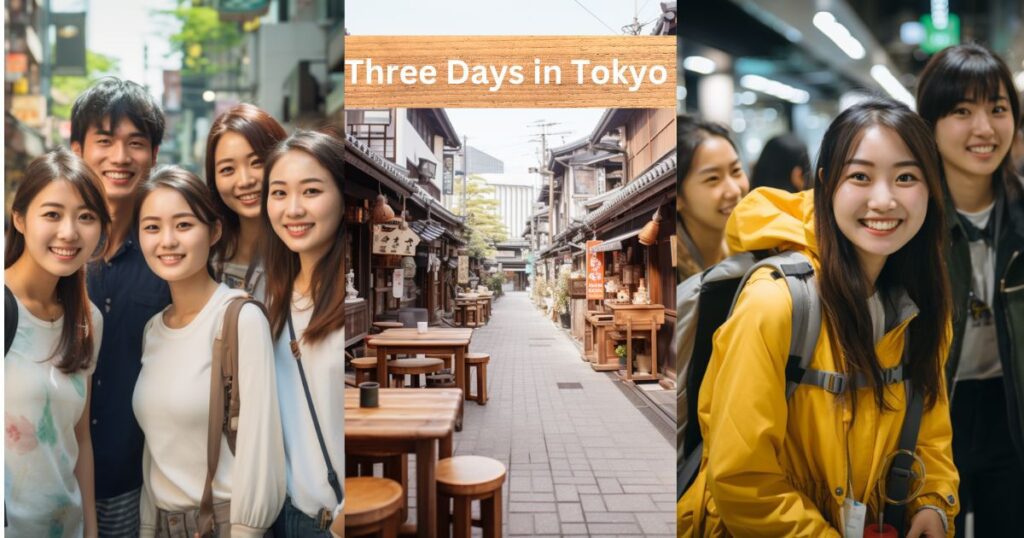Welcome to Tokyo—a city that’s both an ancient wonder and a futuristic playground! Here, sky-high towers share the skyline with historic temples, and world-class sushi exists side by side with bustling markets.
Overwhelmed by choices?
Don’t worry; My 3-day itinerary is your ultimate guide.
I aim to offer you a well-rounded Tokyo adventure, covering its iconic landmarks, hidden treasures, and irresistible cuisine. This guide is perfect for anyone—from first-time visitors to solo explorers and lovebirds looking for a unique getaway.
Ready for an unforgettable journey?
Let’s dive into three days packed with Tokyo’s most remarkable sights and experiences!
Day 1: The Heart of Tokyo
There’s no better way to dive into the beating heart of Tokyo than by exploring its intricate blend of tradition and modernity. And what better place to kickstart this journey than the iconic Tsukiji Fish Market?
Morning: Tsukiji Fish Market
Description
Often cited as the world’s largest seafood market, Tsukiji Fish Market is a hive of frenetic activity, captivating sights, and irresistible aromas.
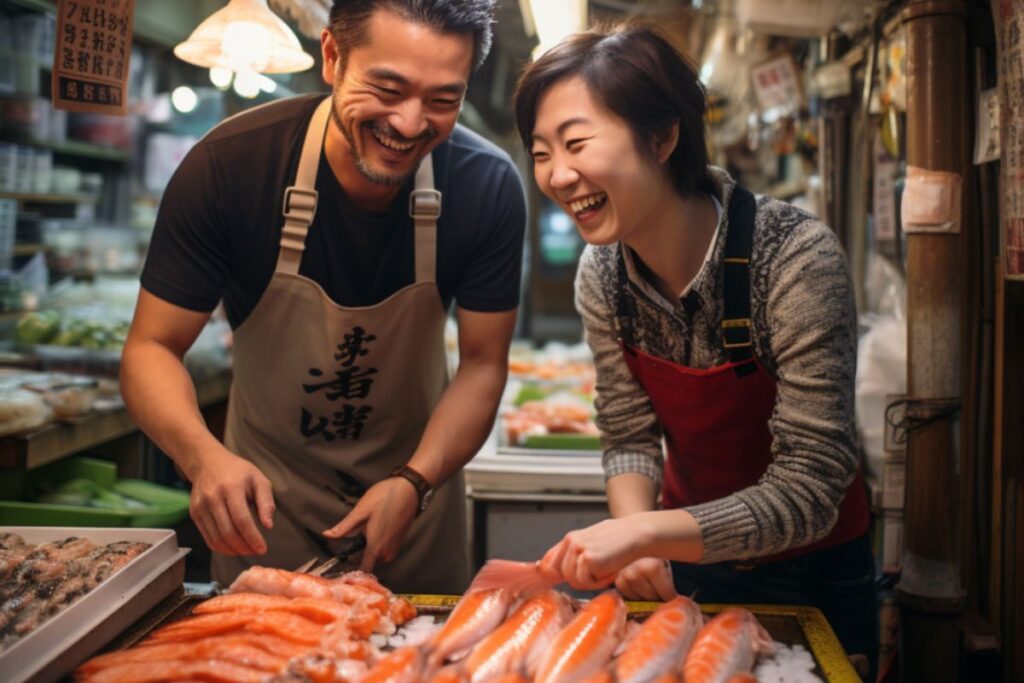
While the wholesale inner market has moved to Toyosu, the Tsukiji Outer Market remains an indispensable experience for visitors. From chefs haggling over the freshest catch to vendors skillfully slicing tuna, this market offers an unfiltered glimpse into Tokyo’s vibrant culinary culture.
What to Eat?
- Sushi: This is arguably the freshest sushi you will ever taste. Look for sushi counters where you can see chefs slicing the fish right in front of you.
- Tamagoyaki (Japanese omelet): You can watch vendors cook these sweet, layered omelets on rectangular pans. It’s the perfect snack as you stroll around.
- Seafood Bowls: Dive into a bowl of mixed sashimi served over a bed of rice for a hearty brunch.
- Fresh Fruit and Vegetables: Don’t miss out on seasonal produce—whether it’s juicy strawberries or uniquely Japanese vegetables.
Tips for Visiting
- Timing is Everything: While the market is generally open from 5 a.m. to 2 p.m., the best time to visit is between 7 a.m. and 9 a.m. when the activities are at their peak.
- Cash Only: Most vendors don’t accept cards, so be prepared with enough cash for your gastronomic adventure.
- Be Mindful: This is a bustling, working market, so always be conscious of your surroundings to avoid disrupting the vendors.
- Try Before You Buy: Many vendors offer samples. It’s a great way to discover new flavors but always ask for permission first.
- Dress Appropriately: Closed-toe shoes are advised as the market floors can be wet and slippery.
By the time you leave Tsukiji Fish Market, not only will you have a belly full of some of Tokyo’s best offerings, but you’ll also carry with you an enriching understanding of the city’s culinary DNA.
Midday: Imperial Palace
Historical Context
In the heart of Tokyo, surrounded by modern skyscrapers, lies the Imperial Palace—a sanctum of tradition and history. The residence of Japan’s Imperial Family, built on the former site of Edo Castle, is a lasting connection to the country’s history.
Although the inner grounds are generally closed to the public, the East Gardens and the surrounding areas offer enough spectacle to fill your cultural appetite.
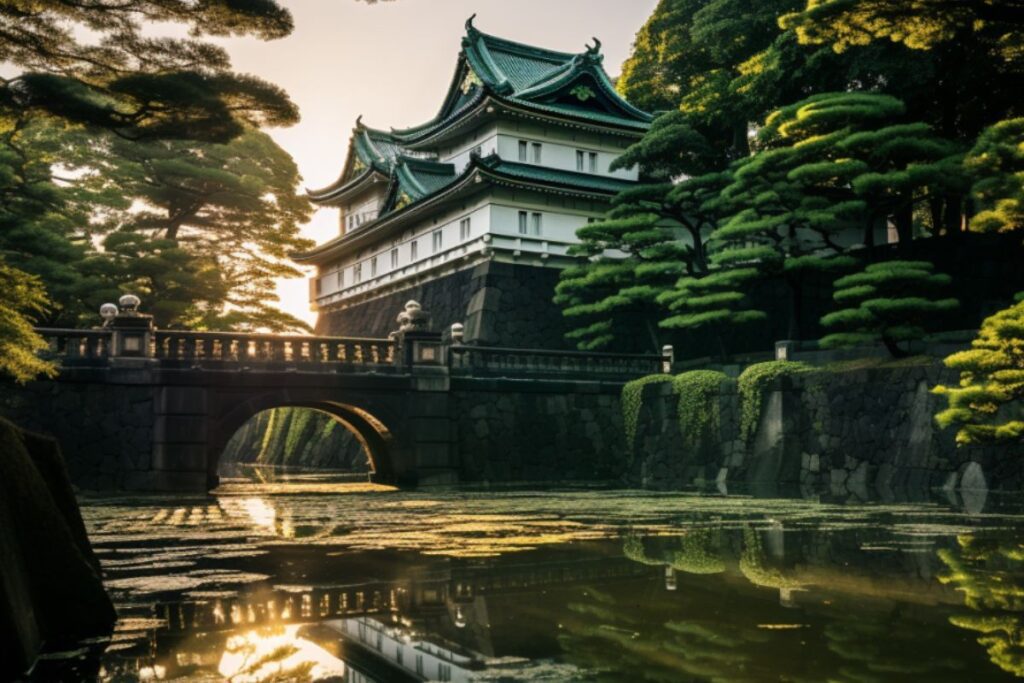
The juxtaposition of the centuries-old structures against Tokyo’s modern skyline is a living testament to Japan’s unique blend of old and new.
Best Photo Spots
- Nijubashi Bridge: The stone bridge and its reflection over the moat create one of Tokyo’s most iconic scenes.
- Kikyo-mon Gate: This gate offers a serene backdrop and is usually less crowded.
- East Gardens: Particularly beautiful during cherry blossom season, the East Gardens offer plenty of photo opportunities with the foliage and ancient walls.
- Watchtowers: Capture the old architecture of the watchtowers contrasted against the modern skyscrapers in the background.
Nearby Attractions
- Kokyo Gaien National Garden: An expansive plaza that offers sweeping views of the palace and the surrounding skyscrapers.
- Marunouchi: One of Tokyo’s premier business districts with upscale shops and restaurants, just a short walk from the palace.
- Hibiya Park: A Western-style park that serves as an oasis amid Tokyo’s bustling city life, perfect for a relaxed lunch.
- Museum of Modern Art, Tokyo: If you’re an art enthusiast, this museum houses an impressive collection near the palace.
Whether you’re a history buff or a casual traveler, the Imperial Palace offers an enriching experience that melds Japan’s past and present. It serves as a peaceful interlude during your adventurous Tokyo day, and it’s a must-visit for capturing the city’s essence.
Afternoon: Ginza District
Shopping Opportunities
Ginza stands as the pinnacle of Tokyo’s upscale shopping scene. Walking down Chuo-dori Street, you’ll find various luxury brands that define the district’s opulence. From international giants like Chanel and Louis Vuitton to Japanese stalwarts like Shiseido and Mikimoto, Ginza offers a shopping experience unlike any other.
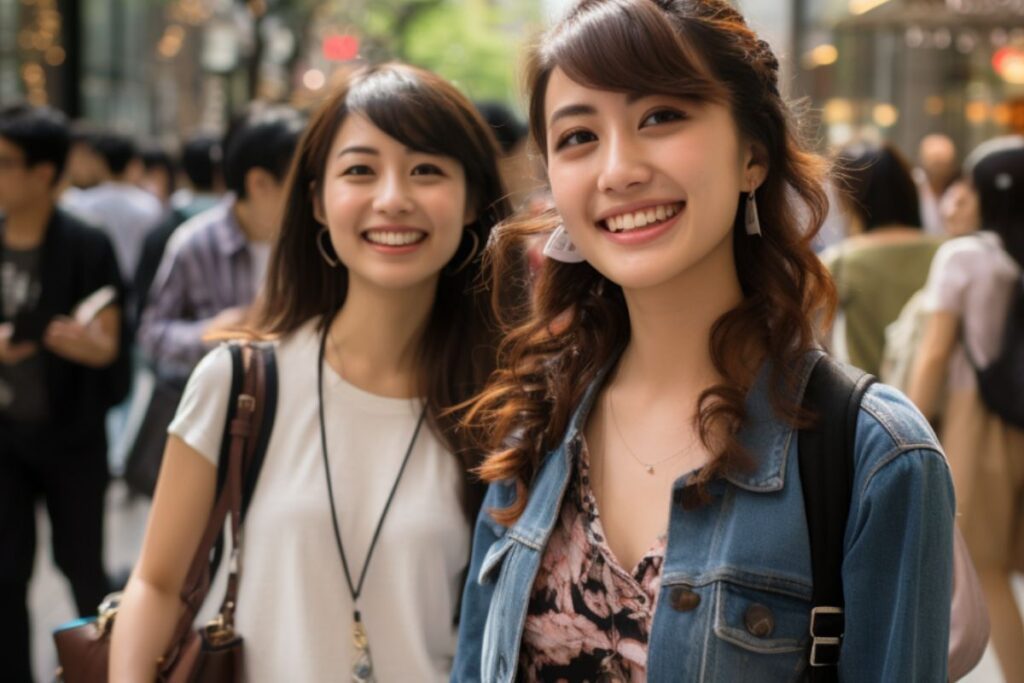
Here, elegance and sophistication come to life, making it a must-visit locale for anyone interested in fashion, beauty, or simply indulging in the finer things.
- Ginza Six: This luxurious shopping complex houses over 240 stores offering everything from fashion to homewares.
- Wako Department Store: A historic store famous for its watches, jewelry, and finely crafted items. Don’t forget to admire the iconic clock tower while you’re there.
- UNIQLO’s Global Flagship Store: For more budget-friendly options, visit this multi-level clothing emporium.
Coffee and Tea Shops
Ginza is not just about shopping; it’s also a haven for coffee aficionados and tea connoisseurs.
- Higashiya Ginza: This spot offers a modern twist on traditional Japanese teas and sweets.
- Café de l’Ambre: A vintage coffee shop that has been serving meticulously brewed coffee since 1948.
- Starbucks Reserve Roastery: For those looking for a familiar name but an elevated experience, this Starbucks outpost in Ginza is one of the most luxurious ones you’ll find.
Cultural Aspects
Beyond the glitz and glamour, Ginza also offers slices of Tokyo’s cultural fabric.
- Kabuki-za Theatre: Experience Kabuki, a traditional Japanese performance art, in Japan’s most famous Kabuki theater.
- Ginza Graphic Gallery: Known for showcasing graphic art, this gallery elevates commercial design to the realm of fine art.
- Sony Park: This open-air, multi-level space often hosts free public exhibitions and performances and offers an exciting look at urban design.
An afternoon in Ginza provides the opportunity to indulge in luxury and a platform to explore Tokyo’s evolving lifestyle and cultural scenes.
Whether you’re interested in snagging the latest fashion pieces, sipping on some of the world’s best coffee, or diving into Tokyo’s rich artscape, Ginza has something for everyone.
Evening: Shibuya Crossing
The Experience of the Crossing
As dusk settles, go to the famous Shibuya Crossing, often dubbed “The Scramble.” This bustling intersection outside Shibuya Station is a spectacle of organized chaos, with up to 3,000 people crossing the road at the same time from all directions.
Standing amid the flood of pedestrians and neon billboards, you’ll feel the city’s pulse and realize why this spot is a symbol of Tokyo’s dynamism.
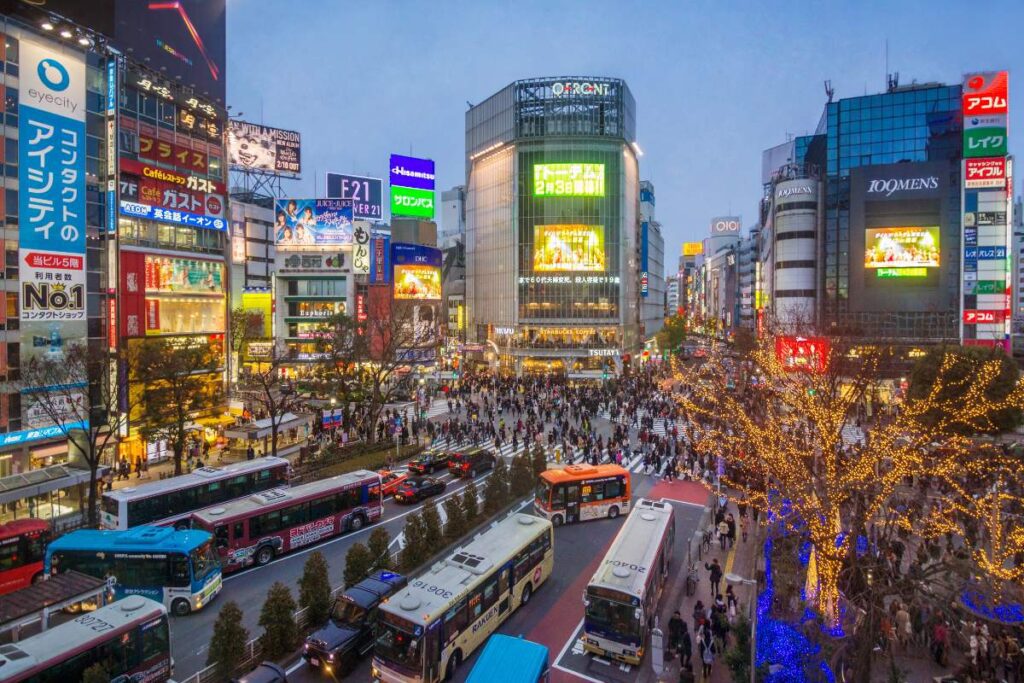
For an elevated view, head to the Shibuya Sky observation deck or one of the cafes overlooking the crossing.
Dining Options
Shibuya offers many dining options catering to all palates and budgets.
- Ichiran Ramen: This chain offers some of the best tonkatsu ramen in unique booth-style seating.
- Uobei Shibuya Dogenzaka: For sushi lThis sushi train restaurant offers quality sushi at affordable prices.
- JBS: A Ja for sushi loverszz, Blues, and Soul bar with a vast whiskey selection, perfect for those looking for a low-key dining experience.
Nightlife
Shibuya is a nightlife hotspot, offering something for everyone.
- Womb: One of Tokyo’s premier nightclubs, famous for its electrifying electronic music.
- Two Dogs Taproom: Offers a wide selection of craft beers and is popular among expats and locals alike.
- Nonbei Yokocho: Also known as Drunkard’s Alley, this narrow lane is lined with small izakayas and bars, offering a more traditional Japanese nightlife experience.
- Love Hotel Hill: For those intrigued by Tokyo’s quirky side, a stroll through this area, known for its uniquely themed love hotels, can be a cultural experience in its own right.
An evening in Shibuya brings Day 1 of your Tokyo adventure to a climactic end. Whether you’re a foodie, a party-goer, or simply someone looking to soak in the city’s modern vibes, Shibuya provides the perfect backdrop to experience Tokyo in all its nighttime glory.
Day 2: The Cultural Experience
Tokyo’s kaleidoscopic personality extends beyond its skyscrapers and neon lights. Day 2 of your Tokyo 3-Day Itinerary journey dives deep into the cultural and spiritual aspects of this multifaceted city.
Morning: Asakusa & Senso-ji Temple
History
Asakusa is a district in Tokyo that harks back to the city’s Edo era, providing a stark contrast to the futuristic landscape. At the heart of Asakusa is Senso-ji, Tokyo’s oldest temple, founded in the 7th century.
According to legend, a statue of Kannon, the goddess of mercy, was discovered by two fishermen in the Sumida River. As a result, the temple was constructed to honor this deity.
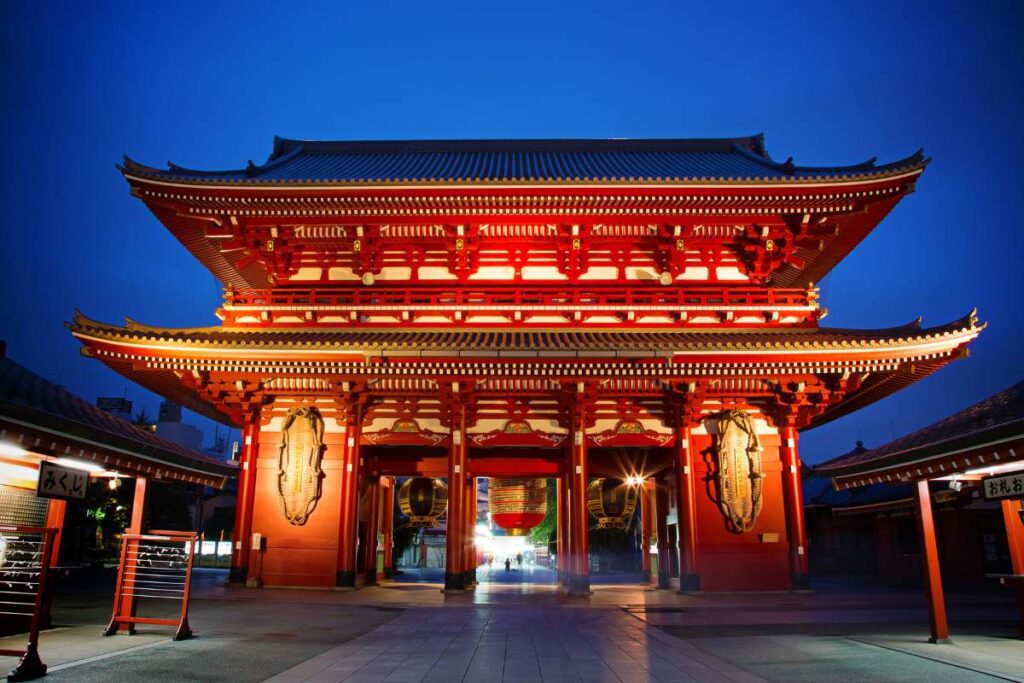
Over the years, Senso-ji has survived calamities like air raids during WWII and has undergone several restorations, standing today as a testament to Tokyo’s resilience and devotion.
What to See and Do
- Kaminarimon (Thunder Gate): This iconic gate is the outer entrance to Senso-ji Temple and is guarded by the deities Raijin (God of Thunder) and Fujin (God of Wind). Don’t forget to snap a photo with the gigantic red lantern.
- Nakamise-dori: A shopping street stretching over 200 meters from Kaminarimon to the temple’s main hall, offering a variety of traditional, local snacks as good for tourist souvenirs.
- Main Hall and Five-Storied Pagoda: Once you pass through Hozomon, the inner gate, you’ll reach the temple’s main hall and adjacent pagoda. Spend some time here to soak in the spiritual atmosphere, offer prayers, and perhaps participate in omikuji, a traditional form of fortune-telling.
- Asakusa Culture and Tourism Center: For a panoramic view of Asakusa and the Tokyo Skytree, head to the top of this uniquely designed building.
- Sumida Aquarium and Tokyo Skytree: If you have some extra time, these modern attractions are a short train ride away and offer both leisure and fantastic views of the city.
Asakusa and Senso-ji Temple offer a tranquil beginning to Day 2, setting the tone for a day focused on Tokyo’s rich cultural tapestry.
Whether you’re interested in history, spirituality, or simply enjoying some traditional Japanese snacks, this morning excursion promises a feast for the soul and the senses.
Midday: Ueno Park and Zoo
Picnic Spots
Midday is the perfect time to visit Ueno Park, a sprawling oasis amid Tokyo’s urban jungle. The park provides a tranquil setting for a picnic, allowing you to relax and recharge as you escape the city’s hustle and bustle.

In addition to its lush greenery, Ueno Park is home to a renowned zoo. After your picnic, consider exploring the animal exhibits to add an educational twist to your leisurely day.
- Shinobazu Pond: Offering scenic views of lotus plants and ducks, this is a popular picnic spot year-round.
- Ueno Toshogu Shrine: Nestled in a grove of cherry and gingko trees, the area near this ornate shrine is peaceful and picturesque.
- Open Fields near Ueno Zoo: Grab a bento box from one of the nearby vendors and enjoy lunch while watching zoo-goers and local families at play.
Museums
Ueno Park is not just a recreational space; it’s also a cultural hub housing some of Tokyo’s most prominent museums.
- Tokyo National Museum: This museum is a must-visit for history enthusiasts, boasting a vast collection of Japanese and Asian art and antiquities.
- Ueno Royal Museum: This privately owned facility frequently hosts temporary exhibitions from diverse artists.
- National Museum of Nature and Science: An excellent choice for families or anyone interested in the natural world, offering exhibits on everything from dinosaur skeletons to the universe.
- The Ueno Zoological Gardens: While not a museum in the traditional sense, the zoo itself is Japan’s oldest and offers a mix of animals from around the world, including a famous panda exhibit.
The midday experience at Ueno Park offers a wonderful balance of relaxation and intellectual stimulation. It’s an opportunity to recharge and delve into different facets of Japanese culture and history.
Afternoon: Akihabara
For Tech and Anime Fans
Head to Akihabara, or “Akiba,” the go-to district for tech and anime aficionados in the afternoon. The area teems with shops offering cutting-edge gadgets and pop culture merchandise.
Whether you’re a tech geek or an anime lover, Akihabara is a must-visit. Its bustling streets and niche stores offer a slice of modern Japanese culture that’s too vibrant to miss.
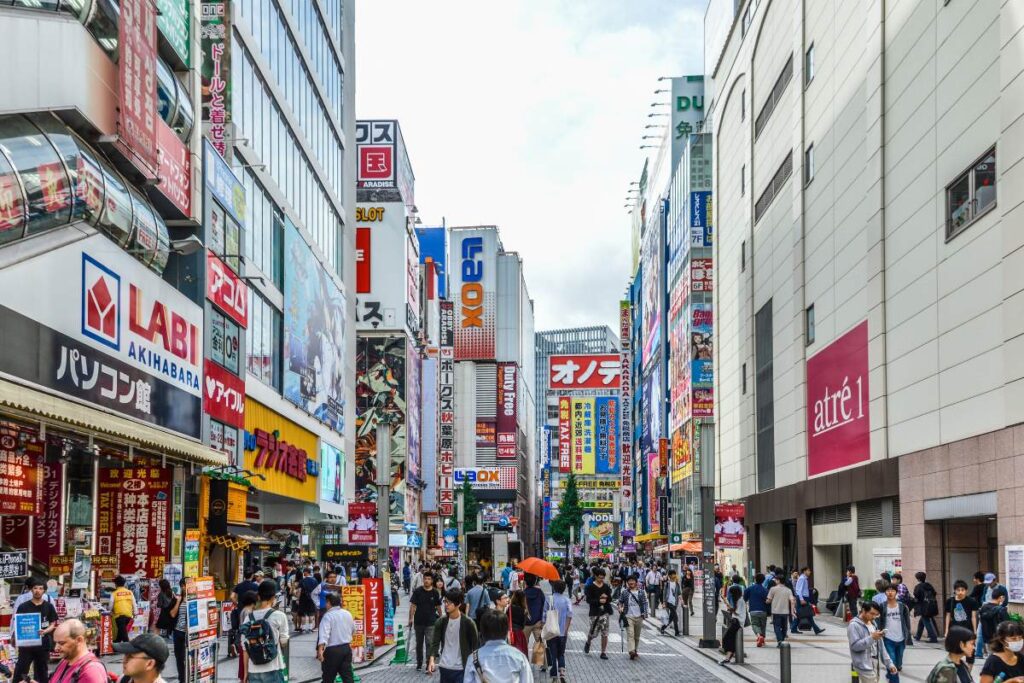
Whether you’re a tech geek or an anime lover, Akihabara is a must-visit. Its bustling streets and niche stores offer a slice of modern Japanese culture that’s too vibrant to miss.
- Yodobashi Camera: One of the largest electronics stores in Japan, where you can find anything from camera lenses to kitchen appliances.
- Animate: A multi-story building filled with anime and manga-related goods, including limited edition collectibles.
- Tokyo Anime Center: Located in the Akihabara UDX building, this spot offers exhibitions and sells unique merchandise.
Unique Shops and Cafés
Akihabara isn’t just for techies and otakus; its eccentric retail landscape and themed cafés offer something for everyone.
- Gachapon Kaikan: Dive into the world of gachapon—capsule toy vending machines—with hundreds of options to choose from.
- Super Potato: This retro video game store is a paradise for gamers looking for classics from the NES era to the PlayStation era.
- Maid Cafés: One of Akihabara’s signature experiences. At places like @home cafe, maids serve guests in a theatrical, cutesy setting.
- Gundam Café: A must-visit for fans of the iconic Gundam series, offering themed foods and merchandise.
An afternoon in Akihabara provides a compelling contrast to your morning in Asakusa, showing off Tokyo’s broad range from the ancient to the ultra-modern.
Whether you’re into the newest gadgets, a fan of anime and manga, or just interested in unique shopping experiences, Akihabara has a world of wonders waiting for you.
Evening: Odaiba
Attractions
As evening falls, venture to Odaiba, a man-made island set against the backdrop of Tokyo Bay. This entertainment hub boasts a variety of attractions, from shopping malls to art installations.
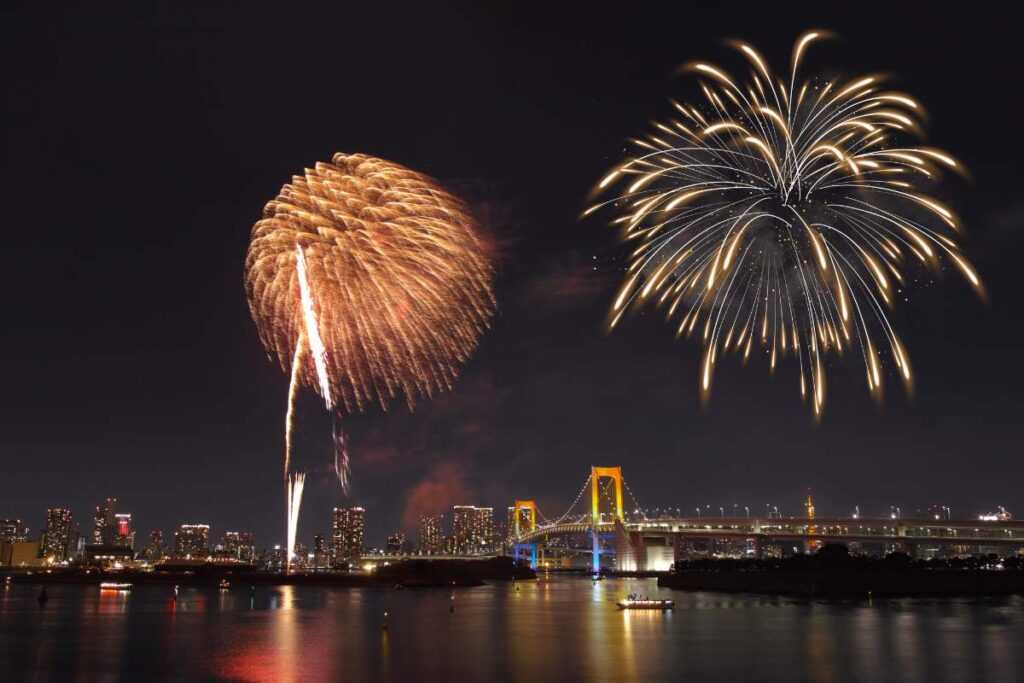
With its scenic bay area views, Odaiba offers a picturesque end to a day of Tokyo exploration. Whether you’re seeking leisure or spectacle, this island has something for everyone.
- Gundam Statue: This world-famous statue attracts millions of tourists every year, located in front of DiverCity Tokyo Plaza.
- TeamLab Borderless and Planets: These are two separate art installations by the digital art collective TeamLab. Borderless offers an immersive, multi-room experience, while Planets is a more tactile, water-based adventure.
- Oedo Onsen Monogatari Hot Springs: Cap off your busy day with a traditional Japanese onsen experience featuring baths from different regions of Japan.
Dinner Options
- Aqua City: This shopping mall offers many dining options, including Japanese and international cuisines.
- Decks Tokyo Beach: Another mall with a seaside view, known for its themed restaurants like the Takoyaki Museum, which serves various styles of the popular octopus snack.
View of Rainbow Bridge
No trip to Odaiba is complete without taking in the panoramic views of Rainbow Bridge, especially magical during its evening light-up.
- Odaiba Seaside Park: Provides excellent views of the bridge and is also an ideal location for some nighttime photography.
- Leisure boats: Several companies offer dinner cruises around Tokyo Bay, providing another angle on the Rainbow Bridge while you dine.
- Odaiba Liberty Statue: This statue is one of the most visited spots in Odaiba. It’s a symbol of Japan and France’s friendship.
Odaiba provides a fitting finale for a day steeped in both tradition and modernity. Whether you’re soaking in the art at TeamLab, enjoying an international dinner with bay views, or capturing the perfect shot of Rainbow Bridge, an evening in Odaiba will surely be memorable.
Day 3: The Modern and Traditional Fusion
The final day of your Tokyo 3-Day Itinerary vacation celebrates the city’s unique ability to fuse the past and present into a harmonious experience. And what better place to start than Harajuku, a district that embodies Tokyo’s youthful energy and creative spirit?
Morning: Harajuku Takeshita Street
Fashion and Culture
Kick off your morning with a visit to Harajuku’s Takeshita Street, the heart of Japanese youth culture and fashion. This iconic street is more than a location; it’s a cultural showcase teeming with trendy boutiques, eclectic shops, and vibrant energy.
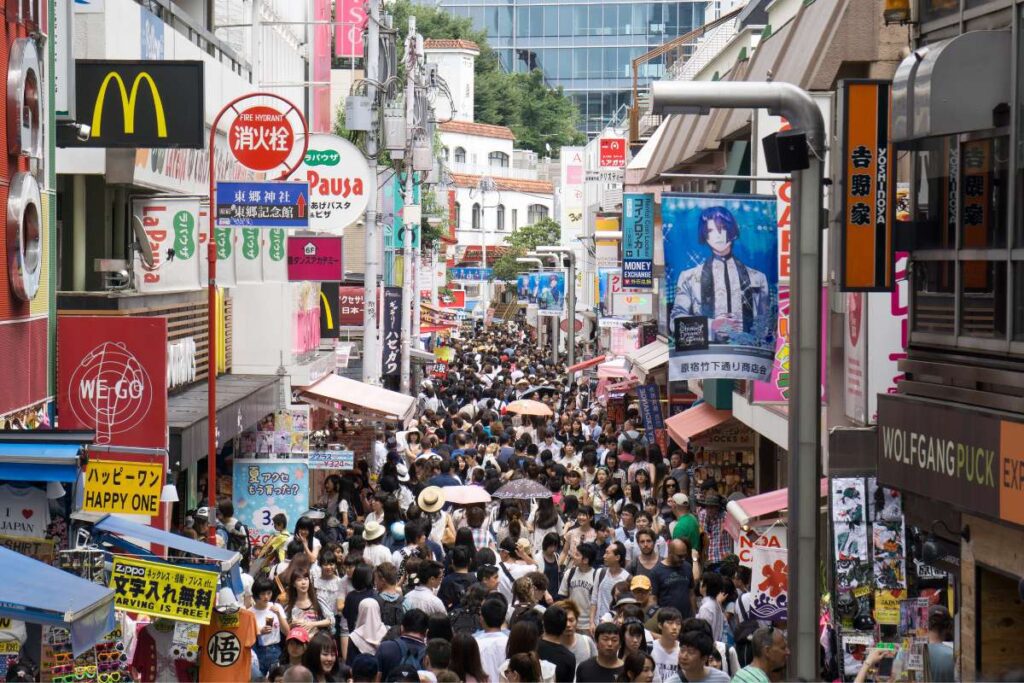
For fashion enthusiasts and culture vultures alike, Takeshita Street is a must-visit. The area provides a fascinating glimpse into the styles and subcultures that define contemporary Japanese youth.
- Boutiques and Vintage Shops: Places like Bubbles and Pin Nap offer unique and vintage clothing, catering to the Harajuku style that has garnered international attention.
- Street Performers and Artists: You’ll find plenty of local talents, ranging from musicians to visual artists, displaying their artistry around the area.
Must-Try Foods
Harajuku is as much about culinary delights as it is about fashion.
- Takeshita Dori Crepes: These are not your regular French crêpes. They come stuffed with everything from whipped cream and strawberries to cheesecake slices.
- Zaku Zaku: Known for its crispy croquant chou sticks filled with almond milk cream.
- Kawaii Monster Cafe: Though more of a visual feast, the cafe also offers colorful and whimsical dishes that complement its extravagant decor.
Beginning Day 3 in Harajuku sets the tone for a day that is as eclectic as Tokyo itself, offering a foray into the city’s contemporary culture while hinting at the traditional elements that have influenced it.
Midday: Meiji Shrine
Tranquility in the City
By midday, the transition from the high-energy streets of Harajuku to the serene grounds of Meiji Shrine. This tranquil shrine is next to the busy Harajuku Station and is a peaceful counterpoint to your morning’s activities.
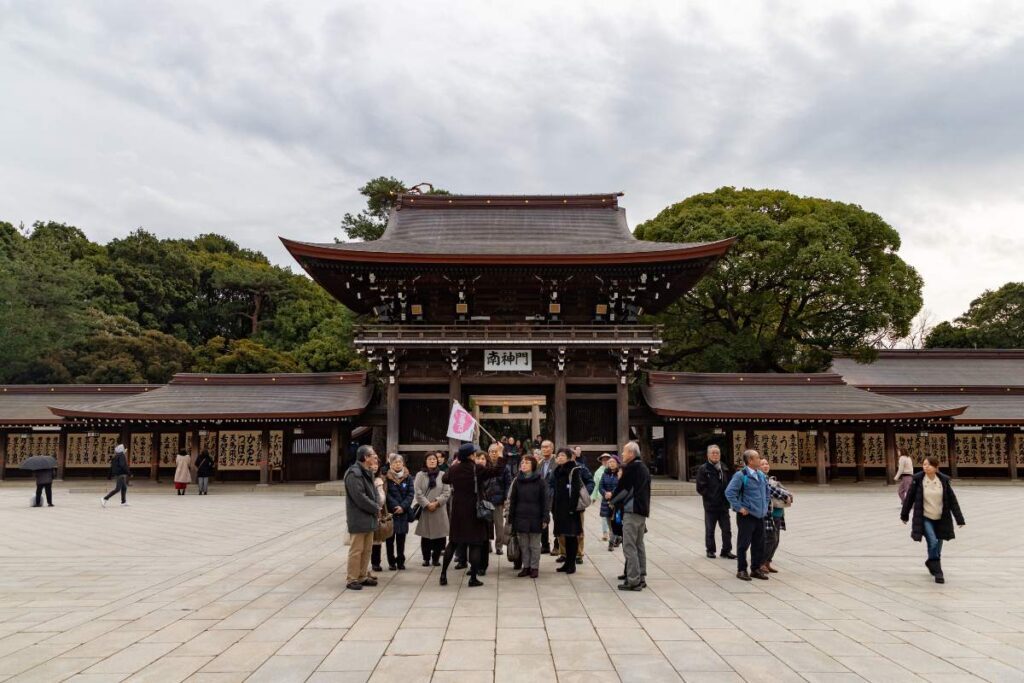
Nestled within an evergreen forest, Meiji Shrine offers a quiet respite where you can escape the city’s buzz. It’s the perfect setting to reflect and recharge before diving into Tokyo’s urban landscape.
- Meiji Jingu’s Forest: This isn’t just any urban forest. It was carefully designed with over 100,000 trees donated from regions across Japan.
- Main Shrine Buildings: The shrine complex itself is a spectacle of traditional Shinto architecture, built without the use of nails. The main buildings are constructed from Japanese cypress and copper.
Rituals and Significance
Meiji Shrine is a place of spiritual significance and offers a window into Shinto practices.
- Temizu: Upon entering, you’ll encounter a purification fountain where you can partake in “temizu,” a ritual cleansing of hands and mouth.
- Offering Prayers: At the main hall, you can make an offering and write down a prayer on an “ema” wooden plaque, which you then hang among others.
- Meiji Shrine Museum: For those interested in diving deeper, this museum explains the history and cultural importance of the shrine and its founders, Emperor Meiji and Empress Shoken.
The midday visit to Meiji Shrine encapsulates the theme of Day 3—harmonizing the modern with the traditional. It is a gentle reminder of Tokyo’s ability to hold onto its past while sprinting into the future.
Afternoon: Shinjuku
Skyscrapers and City Views
Shinjuku stands as Tokyo’s answer to Manhattan, distinguished by its skyline of towering skyscrapers. These architectural marvels offer breathtaking panoramic views of the sprawling city below.
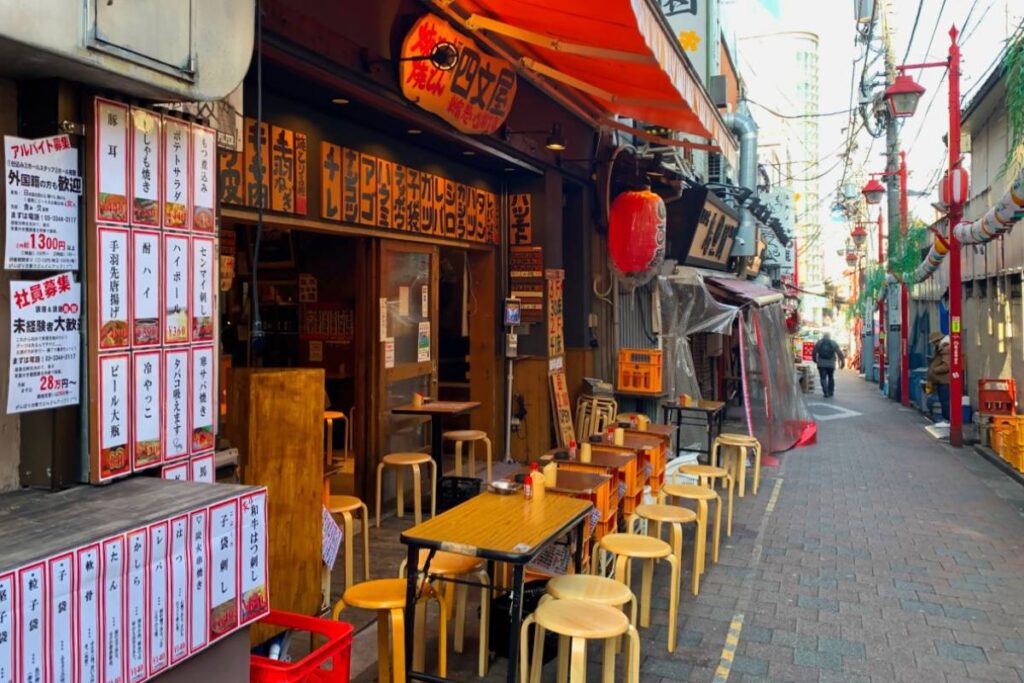
Whether taking in the vista from an observatory or a rooftop bar, Shinjuku offers a visual feast that captures the essence of Tokyo’s modernity and scale. It’s an experience that puts the city’s grandeur into perspective.
- Tokyo Metropolitan Government Building: The observation decks on the 45th floors of both towers are free to access and offer sweeping views of Tokyo.
- Shinjuku Sumitomo Building: Another great option, the Sky Lounge Aura on the 53rd floor, offers a view along with cocktails.
- Shinjuku Red Light District: Kabukicho is known as Shinjuku Red Light District in the world. You experience it, including Golden Gai.
Shopping
Shinjuku caters to every shopper’s fantasy, from luxury boutiques to tech shops and everything in between.
- Isetan: Known as one of Tokyo’s best department stores, Isetan offers high-end shopping, and its food hall is equally impressive.
- Bicqlo: The result of a unique collaboration between electronics giant Bic Camera and clothing retailer Uniqlo, Bicqlo offers a one-of-a-kind shopping experience.
- Don Quijote: This discount store is perfect for finding quirky souvenirs, and it’s open late, offering flexibility for shoppers.
- Takashimaya Times Square: A large shopping complex with many international and Japanese brands.
An afternoon in Shinjuku exposes you to Tokyo’s contemporary heartbeat, capturing the city’s love for innovation and its role as a trendsetter on the global stage. Whether atop a skyscraper or hunting for deals in the busy streets, Shinjuku encapsulates the pulsating energy of modern Tokyo.
Evening: Roppongi
Upscale Dining
As the evening sets in, go to Roppongi, Tokyo’s haven for upscale dining. The district is renowned for its diverse array of gourmet offerings, from traditional Japanese fare to international cuisine.
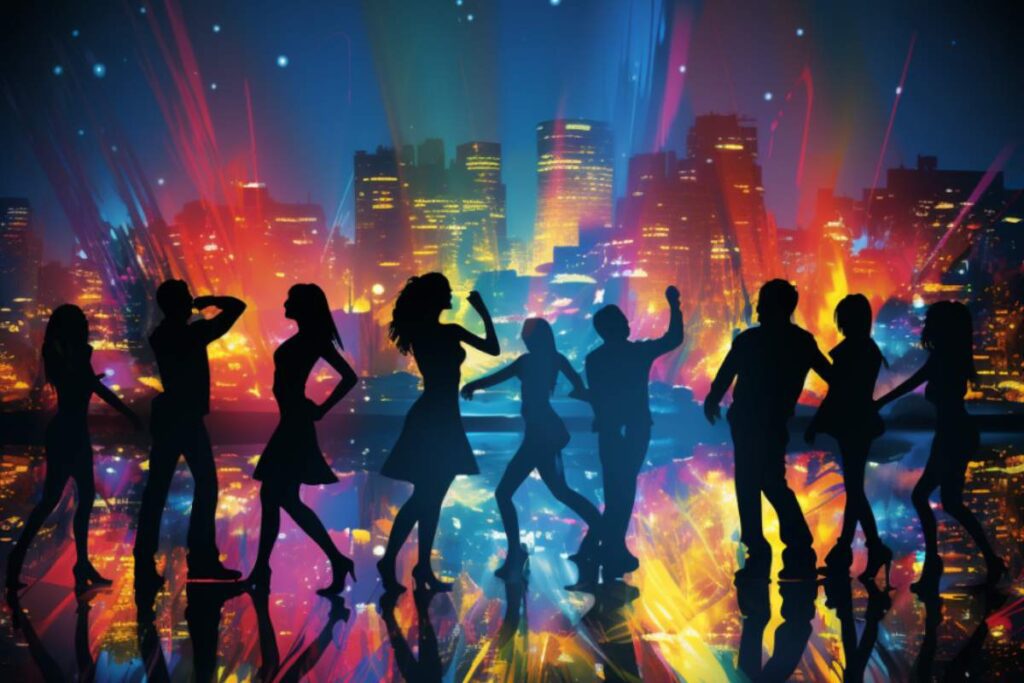
Whether you’re seeking a lavish sushi feast or a Michelin-starred experience, Roppongi provides a culinary journey that promises to satisfy the most discerning palate.
- Sukiyabashi Jiro: For the ultimate sushi experience, you might opt for this Michelin-starred restaurant, although securing a reservation is a feat.
- Two Rooms Grill | Bar: If you’re in the mood for Western cuisine, this establishment offers panoramic city views and finely crafted dishes.
- Inakaya: For something distinctly Japanese but less formal, try this robatayaki (Japanese barbecue) restaurant where you can enjoy fresh vegetables, meats, and seafood grilled before your eyes.
Nightlife and Entertainment
Roppongi is renowned for its vibrant nightlife, offering a medley of options for after-hours entertainment.
- Roppongi Hills: Home to a range of bars, clubs, and even a cinema, this is a great starting point for your evening.
- Tokyo Midtown: Another multi-use complex, it houses the Suntory Museum of Art and a beautifully illuminated park at night.
- Two Dogs Taproom: If you’re a craft beer enthusiast, this taproom offers a wide range of local and imported craft beers.
- Ibex35: For those inclined toward live music, this venue at the top of the Roppongi Hills Mori Tower offers live performances and a breathtaking city view.
An evening in Roppongi is the epitome of Tokyo’s cosmopolitan charm, providing an elegant conclusion to your 3-day exploration of a city that so effortlessly blends the traditional with the modern, the indigenous with the international.
Additional Tips for Tokyo 3-Day Itinerary
Public Transportation Guide
Tokyo’s public transport system is intricate but highly efficient. If you follow these additional tips, your trip will be more comfortable.

Use Google Maps on your iPhone to navigate the train schedule.Besides, you can use an app I mentioned below.
But it would help if you had a wifi for the internet. You can rent a wifi here.
Here’s what you need to know:
- Suica or Pasmo Card: These prepaid cards will make your life easier when using public transport. They’re rechargeable and swipable for almost all forms of transport.
- Tokyo Pass: For tourists, the Tokyo Rail Pass can offer unlimited travel on public transport for a set period.
- Metro App: Download a Tokyo Metro app for real-time updates and to navigate the subway system more efficiently.
Local Customs and Etiquette
Understanding local etiquette is crucial for a respectful and fulfilling travel experience.
- Bowing: A common way to greet or say thank you; the deeper the bow, the more respect shown.
- Tipping: It’s generally not a practice in Japan and could even be considered rude.
- Shoes Off Indoors: Removing your shoes is customary in someone’s home or certain traditional accommodations like ryokan.
Money-Saving Tips
Tokyo has a reputation for being expensive, but savvy travelers can find ways to save.
- Convenience Stores: Also known as “Konbini,” these stores offer affordable, fresh food and are open 24/7.
- Lunch Specials: Many upscale restaurants offer lunch sets at a fraction of the dinner price.
- Free Attractions: Places like Ueno Park, Asakusa, and Odaiba offer many experiences that don’t cost a thing.
- City Passes: Consider purchasing a Tokyo Metropolitan District Pass or other discount passes for unlimited subway and train travel within certain zones.
Tokyo- Symphony of Contrasts:
In just three days, you can experience Tokyo’s multifaceted personality—embracing its ultramodern vibrance and deep-rooted traditions.
Our journey began at the heart of Tokyo, exploring iconic spots like Tsukiji Fish Market, Imperial Palace, and Shibuya. Day 2 took us on a cultural vacation through Asakusa’s historic charm, Ueno’s natural beauty, and Akihabara’s tech-savvy allure.
The final day celebrated the city’s ability to harmonize contrasts, from Harajuku’s youthful culture to Meiji Shrine’s tranquil spirituality and Shinjuku’s urban buzz to Roppongi’s evening elegance.
Final Thoughts and Encouragements
While this itinerary provides a comprehensive yet condensed guide, remember that Tokyo is a city that always has more to offer.
Whether you’re a first-timer eager to tackle all the highlights, a solo traveler seeking varied experiences, or a couple looking for romantic spots, Tokyo is a city that welcomes all with open arms and endless opportunities.
Don’t just see Tokyo—feel, taste, and live it. Each neighborhood, each street, and each person you meet adds a unique layer to your Tokyo narrative. So go ahead, pack your bags, and set forth on your Tokyo adventure. Your personal symphony of contrasts awaits.
